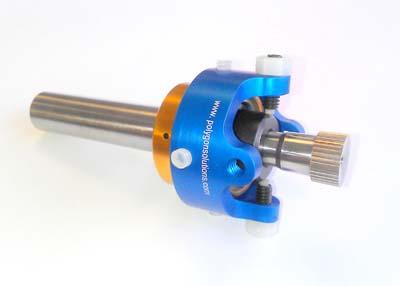
Rotary broaching is fantastic for making small forms like hexagons and squares in soft materials like aluminum, brass and mild steel. However, when it comes to aligning multiple holes using a rotary broaching tool, the operation becomes extremely challenging. Most rotary broach holders have a free turning spindle which does not allow for alignment of the holes. The rotary broaching brake is a new mechanical solution for aligning broached forms in machined products.
Polygon Solutions Inc. designed the broaching brake to be used as an attachment to its innovative GT Series rotary broach holder. The brake mounts to the tool holder using set screws. Additional screws are included at the opening of the brake to gently tighten against the spindle. The broach is fastened into the spindle, and must make contact and be aligned at the first hole.
When the broach is engaged with the part, the brake is loose enough to allow the spindle to turn without interfering with the broaching operation. Unlike typical rotary broaching operations, turning must stop before removing the broach. When the broach is removed, the brake screws are tight enough to hold the broach's position until it makes contact with the part at the next hole.
The rotary broaching brake can be used to hold orientation for single or multiple parts. Tightening the screw to be loose enough to allow broaching, but tight enough to hold orientation requires patience and a level of experience. Some trial and error can be expected and the broach orientation will need to be checked at regular intervals. The hardware consists of standard screws and nuts that can be replaced or reordered easily.
The rotary broaching brake is a lightweight, low profile tool and easily fit into the VMC's tool changer. It easily slides onto the head of the holder and does not require special tools for adjustment or assembly. The brake can also be easily removed for operations where it is not required.
Contact Details
Related Glossary Terms
- broach
broach
Tapered tool, with a series of teeth of increasing length, that is pushed or pulled into a workpiece, successively removing small amounts of metal to enlarge a hole, slot or other opening to final size.
- broaching
broaching
Operation in which a cutter progressively enlarges a slot or hole or shapes a workpiece exterior. Low teeth start the cut, intermediate teeth remove the majority of the material and high teeth finish the task. Broaching can be a one-step operation, as opposed to milling and slotting, which require repeated passes. Typically, however, broaching also involves multiple passes.
- turning
turning
Workpiece is held in a chuck, mounted on a face plate or secured between centers and rotated while a cutting tool, normally a single-point tool, is fed into it along its periphery or across its end or face. Takes the form of straight turning (cutting along the periphery of the workpiece); taper turning (creating a taper); step turning (turning different-size diameters on the same work); chamfering (beveling an edge or shoulder); facing (cutting on an end); turning threads (usually external but can be internal); roughing (high-volume metal removal); and finishing (final light cuts). Performed on lathes, turning centers, chucking machines, automatic screw machines and similar machines.
